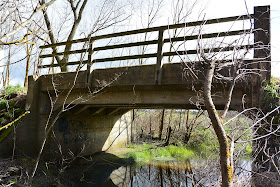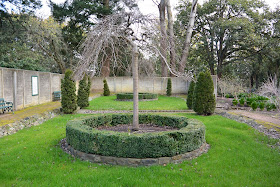CCP Wilson, was born in Geelong around 1857 and learnt his trade working with his father. Between them, father and son were responsible for the design and construction of dozens of bridges, roads, public buildings and civic facilities across the Western Districts of Victoria in the 19th and early 20th centuries, many of them involving the Barwon River and its tributaries.
 |
| Charles Corbett Powell Wilson, shire engineer to Leigh, Meredith and Buninyong Shires |
Whilst much of the work undertaken by Wilson involved the maintenance of existing roads and bridges, like his father, he too was responsible for the design of a significant number of bridges and other civil structures, a number of which are still standing to this day. Building on the pioneering work of his father, he was a huge supporter of the use of reinforced concrete as a cheap, durable and low-maintenance building product and there are several bridges still standing today as testament to the validity of his thinking.
One of his earliest and most significant projects was of course, the Leigh Grand Junction Bridge about which I have written in detail in previous posts and which dates to 1910. Located at the boundary of the three shires he served, it is a fitting testament to his many contributions.
 |
| Leigh Grand Junction Bridge, August, 2015 |
Wilson then went on to note that 17 years earlier, his brother had drawn up plans to have the second bridge replaced with a steel structure, however this was deemed too expensive by council who decreed that a timber structure should be built instead - a decision which undoubtedly resulted in the construction of the bridge which still stands today.
 |
| Cooper's Bridge aka the Moorabool Bridge, August, 2015 |
Whilst the guard rails have today been replaced with modern edging, the rest of the structure appears to remain much as described in 1913. In total, the new bridge cost a grand sum of £763, of which £68 was the cost involved in removing the previous structure. The original bridge had cost the shire £700.
By 1904 it was reported that the centre bearers of the western span of the bridge were completely rotten and it was recommended that this part of the bridge be removed and replaced with an embankment. There is no suggestion that this plan was adopted and the repairs continued until the end of 1914 when construction finally began on a new concrete bridge, designed by CCP Wilson. The project was completed by February the following year, however with increasing wartime austerity, it was deemed that the money required for a grand opening would be better spent on other road works and so the bridge was opened quietly, without the pomp and ceremony which accompanied the opening of the Grand Junction and Moorabool bridges. It was remarked none-the-less, that the bridge was the most handsome, strong and best-looking bridge on river.
 |
| Sharp's Crossing Bridge over the Moorabool River, November, 2011 with the trademark pipe and wire handrails of a CCP Wilson design, still intact |
He is indicated as having "erected a new concrete bridge over the Moorabool River below Egerton" early in 1914, however I suspect his contribution was to re-deck the existing Blue Bridge (now heritage listed) which was originally constructed in 1870 with a timber deck atop a bluestone pier and abutments. Wilson's changes typically introduced a concrete deck, reinforced and braced with steel rails.
 |
| Section of the Blue Bridge on the Yendon-Egerton Road |
 |
| Small concrete bridge on Hopgood's Road, Clarendon |
 |
| Detail showing both cable steel and bars of mild steel used in the construction |
 |
| Franklin's Bridge on the Scotchman's Lead-Napoleon's Road |
 |
| Sunken gardens in the old concrete swimming pool at the Buninyong Botanic Gardens |
 |
| Inside the garden |
 |
| A view of the gardens from above |
And so it continued with CCP Wilson serving as shire engineer of Meredith until the merger of that shire with neighbouring Bannockburn Shire in 1915, after which he continued to hold joint positions with Leigh and Buninyong until the time of his death on the 8th January, 1938 at the age of 80. Despite ill health for some time prior, he had continued to perform his role as engineer to both shires as well as holding the role of shire secretary to the Buninyong Shire from the mid 1920s.
Today, despite nearly 80 years having passed since the death of this revolutionary engineer, his legacy remains in the form of the many structures he designed all those decades ago which continue to stand - perhaps much longer than CCP himself could ever have imagined.
No comments:
Post a Comment